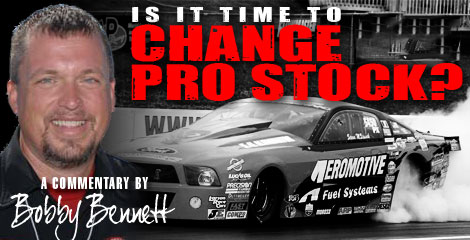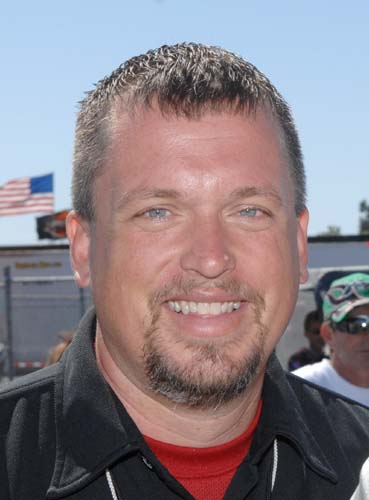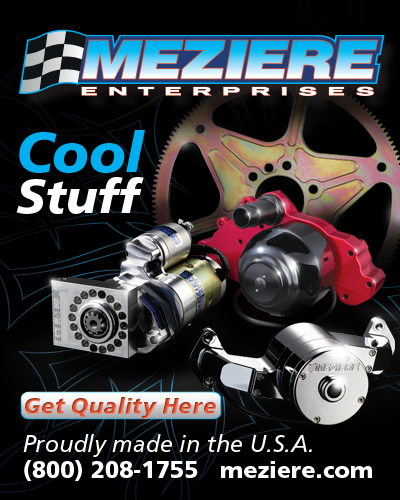BOBBY BENNETT: IS NOW THE TIME TO CHANGE PRO STOCK?
Tue, 2011-02-22 20:54
 Sheryl Crow sang a song which suggested, “A change will do you good”.
Sheryl Crow sang a song which suggested, “A change will do you good”.As a lifelong drag racing fan and respecter of the technical attributes of a Pro Stock car and what it takes to race one competitively, I wonder if Crow’s song could or would be appropriate for the NHRA’s Pro Stock division.
After all, the last time a significant engine rules package was introduced was 30 years ago.
Following a 1981 season where the NHRA Pro Stocks were continually upstaged by their lesser known IHRA mountain motor brethren [i.e. Warren Johnson, Rickie Smith and Ronnie Sox] the sanctioning body brass decided the time had come for a change. Out was the pounds per cubic inch formula structure and in was the IHRA’s basic premise of big inch motors at 2,350 pounds.

As a lifelong drag racing fan and respecter of the technical attributes of a Pro Stock car and what it takes to race one competitively, I wonder if Crow’s song could or would be appropriate for the NHRA’s Pro Stock division.
After all, the last time a significant engine rules package was introduced was 30 years ago.
Following a 1981 season where the NHRA Pro Stocks were continually upstaged by their lesser known IHRA mountain motor brethren [i.e. Warren Johnson, Rickie Smith and Ronnie Sox] the sanctioning body brass decided the time had come for a change. Out was the pounds per cubic inch formula structure and in was the IHRA’s basic premise of big inch motors at 2,350 pounds.
However, the one area the NHRA differed from the IHRA was their limitation of displacement. The IHRA proclaimed the sky was the limit while the NHRA played the conservative role and capped their engines at 500 cubic inches, which was probably the right thing to do with the wealth of deep pockets in their fraternity.
Ten years passed and still no increase in size.
Twenty years … still nothing.
In fact, the only significant engine rule changes was the spirited Memphis memo issued in 1995 reminding Pro Stock racers that nitrous oxide was illegal and exotic metals inside of the engines were prohibited a decade later.
But really, that’s it.
Maybe now is as good as any time to rebrand the face of Pro Stock, at least between the fenders.
It would be neat to see modern day technology intermingle with the age-old institution of Pro Stock. Get rid of the hood scoops, the 500-inch engines and for once in the history of the class, allow a power adder.
Maybe it’s time we consider sports cars as well if we are going to be open-minded. For that matter, after all these years, maybe we ought to include Toyota in our makeover. Certainly NASCAR had no problem finding a way to take their money.
a d v e r t i s e m e n t
Click to visit our sponsor's website
Two years ago, Competitionplus.com presented by Attitude Apparel published a story suggesting Steve Matusek’s then BB/Altered Turbocharged Shelby Mustang epitomized what a Pro Stocker ought to look like.
Matusek’s engine displaced 323-cubic inches, utilized electronic fuel injection and was turbocharged. Before you draw the conclusion this combination would be a step back from the current 500-inch program, consider this: Matusek’s Shelby ran as quick as 6.47 seconds at 222 miles per hour. Just to give you an idea of how close to OEM Matusek’s car really was, it had the same cylinder head and valve configuration as the 2010 Cobra Jet Mustang.
Matusek once told me that he had about a tenth of the cost in blocks and cylinder heads as the current 500-inch configuration now employed by the NHRA Pro Stockers.
Cheaper and more horsepower … hmm.
So here’s my proposal.
Since Detroit doesn’t realistically sell a production engine of 500-cubic inches, why not find a compromise of 358 inches – the equivalent of NASCAR and the defunct Pro Stock Truck class. Do away with the carburetors and implement electronic fuel injection. And, for the first time legally since the class began, allow a factory power adder such as twin-turbochargers or an under-the-hood supercharger for the added push. The cars should weigh 2,350 pounds.
I discussed my ideas with a few past and present engine builders and of those I spoke to, the majority pointed out that a rule change of this magnitude would create an unhealthy burden on the teams, while others pointed out there’s no real reason to institute a change. One engine builder saw no value to the proposal and added each run would explode an engine. Only one out of the group believed it might be pretty neat.
NASCAR unveiled their plans to go EFI in 2012 and I wouldn’t be surprised if by 2013 the NHRA has a plan in place to do away with carburetors as well.
If we’re going to change, let’s make it wholesale.
The last time the NHRA made a major engine combination move many teams were notified of the move from the pounds per cubic inch formula to the standard 500-inch program just months in advance. The teams who usually ran the large displacement small blocks clearly had the advantage while those who raced IHRA were immediately competitive. The teams who ran the smaller engines like Bob Glidden quickly found themselves scrambling in the short off-season to build a new combination.
The only reasonable way to make a complete overhaul would be a two year advance notice. For that matter, there could be a transition period where teams could run one or the other.
For the manufacturers, could there actually be an advantage to open competition amongst their major musclecar platforms from Ford’s Cobra Jet to GM’s LS to Chrysler’s Hemi?
For the first time since 1981, couldn’t a Pro Stock fan honestly root for their favorite manufacturer with a certainty they were cheering for a real extension of the manufacturer?
You know, there was a time when the manufacturers were chasing the technology developed in Stock, Super Stock and Pro Stock. Nowadays the manufacturer technology is so far ahead of the Pro Stock class that neither the rule makers nor the participants want to pursue it, hence the fear of electronic fuel injection and the belief “it can’t be policed”.
Truth be known, for as much as the Pro Stock’s diehards have looked down on Pro Modified, the outlaw doorslammers are on the cutting edge of technology while the factory hot rods are still trying to slice their combination with a dull blade.
That’s not a knock on Pro Stock or its value, but the reality is, electronic fuel injection has been in Pro Modified for nearly a decade and the turbochargers are poised to make a real run at superiority.
If you were lucky enough to be in Bristol, Tenn., during a fall weekend in September 1986, Buddy Ingersoll provided a glimpse of what a futuristic Pro Stocker should be.
Ingersoll gained special permission from the IHRA’s technical department to run his twin-turbocharged, 260-inch V-6-powered Buick Regal in their Pro Stock category against the 700-plus cubic inch competition. Not only did Ingersoll qualify for the event, but also reached the final round where he lost to Pro Stock legend Bob Glidden.
For his efforts, Ingersoll’s Buick was banned from the IHRA’s professional competition and withdrawn from consideration in NHRA Pro Stock.
I can honestly say that Ingersoll’s efforts were way ahead of the time, as far as motorsports was concerned.
But, now, what’s the excuse?
Maybe this is the fan in me talking and not the Pro Stock team owner who has socked away a life’s savings into running a 500-inch program. My suggestions cost me nothing. For him, his overhead has increased drastically in a complex economy.
Is there really ever a good time to change?
Probably not, so now is as reasonable as any time to make a move.
Or do we need to change a proven formula? I think we all remember the Coca-Cola Classic debacle where they changed the formula of a proven product back in the 1980s.
I digress.
It’s been a long time since a real factory hot rod resembled one.
Hopefully our dinosaurs won’t go extinct.
WHAT WOULD YOU LIKE TO SEE?
{pollxtbot id=4}
.
| {loadposition feedback} |
Categories:





































